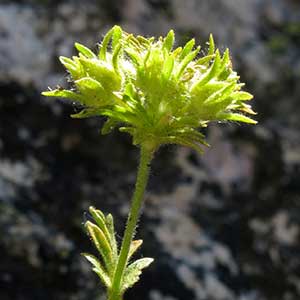Ivesia longibracteata
Ivesia setosa
Castle Crags ivesia, longbract mousetail
bristly ivesia
ascending to erect, 0.3–1.2 dm.
± ascending to nearly erect, 0.7–2.5(–2.8) dm.
weakly planar to loosely ± cylindric, (0.5–)2–4(–6) cm; sheathing base glandular abaxially, otherwise glabrous;
petiole 0.5–2 cm, hairs 0.2–1 mm;
leaflets 5–6 per side, 2–6 mm, ± short-hirsute, glandular-puberulent, lobes 2–7, oblanceolate to spatulate or obovate, apex not setose.
weakly planar to loosely cylindric, 5–9(–12) cm; sheathing base ± strigose abaxially;
petiole 1–8 cm;
lateral leaflets 5–10 per side, separate to overlapping distally, ± flabellate, 2–8 mm, incised ± 3/4 to base, sometimes nearly to base, into (3–)7–11 ovate teeth to narrowly obovate lobes, apex usually ± setose, surfaces ± sparsely hirsute, conspicuously glandular;
terminal leaflets ± indistinct.
1–3, not paired.
(0–)1;
blade vestigial.
3–14-flowered, 1–2.5 cm diam.;
glomerules 1.
(1–)5–15(–30)-flowered, ± open, 1–6(–12) cm diam.
1.5–6 mm.
5–15(–20) mm.
8–10 mm diam.;
epicalyx bractlets linear to narrowly lanceolate or elliptic, 2.5–5 mm, longer than sepals;
hypanthium shallowly cupulate, 0.5–1 × 2–3 mm;
sepals 1.5–2.5 mm, ± acute;
petals pale yellow, linear to narrowly oblanceolate, 1.5–2.5 mm;
stamens 5, filaments 0.7–1.3 mm, anthers yellow, 0.5–0.8 mm;
carpels 6–11, styles 1–1.5 mm.
7–10 mm diam.;
epicalyx bractlets 5, lanceolate, 1.3–2.5(–3) mm;
hypanthium patelliform, (1–)1.5–2 × 2–3.5(–4) mm;
sepals (1.5–)2–3.5 mm, ± acute;
petals yellow, oblanceolate to narrowly spatulate, 1.5–2.5 mm;
stamens 5, filaments 0.8–1.5 mm, anthers yellow, oblong, 0.4–0.7 mm;
carpels 2–8, styles 1.2–2 mm.
cream to light tan, 1.2–1.5 mm.
greenish white to light tan, 1.7–2 mm, smooth, ± carunculate.
Ivesia longibracteata
Ivesia setosa
Of conservation concern.
Ivesia longibracteata is known only from the Castle Crags area of Shasta County. The epithet alludes to a diagnostic characteristic unique in the genus: the epicalyx bractlets are longer than the sepals. The plants grow on vertical rock faces, a habitat more characteristic of sect. Setosae; however, the stems are ascending to erect and do not form hanging clumps, and the pedicels are not curved in fruit.
(Discussion copyrighted by Flora of North America; reprinted with permission.)
Ivesia setosa occurs mostly to the east and south of I. baileyi, from southeastern Humboldt and Churchill counties to Elko, White Pine, and northern Nye counties, Nevada, and in the Deep Creek Range of western Utah. It represents a transition between the planar-leaved, chasmophytic members of sect. Setosae and the cylindric-leaved, matted species of flatter sites. Stems of I. setosa are more generally erect than in other species in the section, and the usually calcareous substrate is noteworthy. The deeply incised (usually not quite to base) leaflets are somewhat intermediate between the toothed leaflets of I. baileyi and the leaflets of I. shockleyi that are incised to the base into separate lobes. The individual leaflets of both I. baileyi and I. setosa are more or less flat and distichously paired; in I. shockleyi, groups of leaflet lobes are folded over onto each other, giving a verticillate appearance to the leaflet arrangement.
(Discussion copyrighted by Flora of North America; reprinted with permission.)


